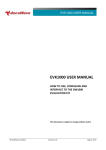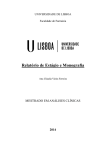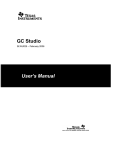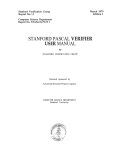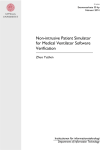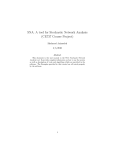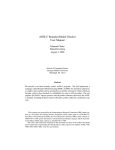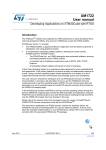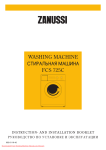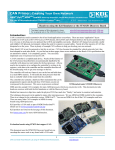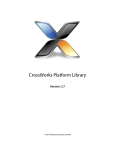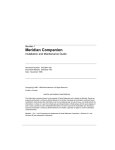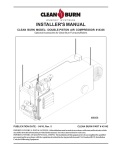Download Automatic Detection of Unspecified Expression Evaluation in
Transcript
IT 14 022
Examensarbete 30 hp
Juni 2014
Automatic Detection of Unspecified
Expression Evaluation in FreeRTOS
Programs
Shahrzad Khodayari
Institutionen för informationsteknologi
Department of Information Technology
Acknowledgements
This is a master thesis submitted in Embedded Systems to Department of Information
Technology, Uppsala University, Uppsala, Sweden.
I would like to express my deepest gratitude to my suppervisor Philipp Rümmer,
Programme Director for Master’s programme in Embedded System at Uppsala University,
for his patience in supporting continuously and generously guiding me with this project.
I would like to appriciate professor Bengt Jonsson for reviewing my master thesis and
offering valuable suggestions and comments.
I would like to thank professor Daniel Kroening for helping me and providing updates of
CBMC.
Sincere thanks to my husband and my incredible parents who gave me courage and support
throughout the project.
Contents
1 Introduction..........................................................................................................1
Contributions.................................................................................................... .............3
Structure of the thesis report.......................................................................................... 3
2 Background...........................................................................................................5
2.1 Verification.................................................................................................... ..........5
2.1.1 Model Checking......................................................................................5
2.1.2 Theorem proving.....................................................................................6
2.2 CBMC.................................................................................................... .................6
2.3 FreeRTOS operating system..................................................................................... 8
2.4 Sequence points..............................................................................................8
3 Unspecified side effects.......................................................................................11
3.1 Arguments Evaluation Order .................................................................................. 11
3.2 A formal semantics for arguments evaluation order.................................................13
4 Algorithm of evaluation order side effect..........................................................17
5 Preparation of analysis ......................................................................................23
5.1 FreeRTOS.................................................................................................... ..........23
6 Implementation...................................................................................................25
6.1 CBMC .................................................................................................... ..............25
6.2 CBMC extension.................................................................................................... 26
7 Evaluation and case study..................................................................................31
8 Related work.......................................................................................................33
9 Conclusion...........................................................................................................35
10 Bibliography.....................................................................................................37
List of Figures
2.1
The model-checking approach
6
3.1
Grammar G
14
3.2
Grammar rules
15
4.1
Operators type in a function’s arguments list
17
4.2
Evaluation order side effect algorithm
18
4.3
Expression Tree
19
4.4
Making Operators relation graphs for expression (a+b)||b++
20
4.5
Making Operators relation graphs for expression ++c[i]-c[j]
21
4.6
Operators relation graphs
22
6.1
Data type of a node in ORG graph
28
6.2
Array indexes assertion
28
6.3
Enabling arguments checker
29
7.1
GCC 4.8.2
31
7.2
Coverity 7.0
32
7.3
Modified CBMC
32
Chapter 1
Introduction
The majority of computer devices are embedded systems. These days cellphones, cameras,
home appliances, robots, industrial machines, traffic lights, trains, airplanes, and many other
devices mainly contain an integration of computer systems. Embedded systems are often
complex and safety-critical. As both their hardware and software complexity are
significantly increasing, reliability moves into the center of attention and needs to be tested
properly.
Testing could be done in different stages, while producing software and it is sometimes as
complex and time consuming as developing the software. Therefore, it is more beneficial to
find bugs at an early stage in software development and provide valuable feedback for
developers, in order to find and fix such problems prior to building up the next modules or
even next release.
Sometimes bugs are due to a bad usage of a documented library or API, because of not
reading the whole manuals or misunderstanding them. An other case could be not only a
programmer's mistakes but also by reason of using complicated programming languages,
like C/C++. In fact, while C/C++ are the most widely used languages for developing such
systems, they are counted as highly prone to errors. These errors might lead to very serious
consequences, including unpredictable and inconsistent program behaviors, run-time errors
and even system crashes. Consequently effective detection of such errors is necessary.
Many embedded system applications use a special operating system called Real Time
Operating System (RTOS). FreeRTOS is an open source RTOS that is used for embedded
platforms such as ARM, Cortex-M3, AVR and STM32. It is written mostly in C and offers a
small and simple real time operating system. It provides one solution for many different
architectures and development tools and it is known to be reliable. In thesis, we use
FreeRTOS as a processor of targeting program which might contain unspecified behavior.
For this purpose, we prepared a minimalist or simplified model of the FreeRTOS API in
form of a C library.
For achieving error detection goal, there are variable verification techniques. Using formal
methods are well-known, which mathematically specify and verify these systems. They give
us a proper understanding of a system and reveal inconsistencies, ambiguities, and
incompleteness that might otherwise go undetected[1].
1
One of the most widely used formal methods is model checking, a technique that relies on
building a finite model of a system and checking if a desired property holds in that model.
Bounded Model Checking (BMC) techniques are able to efficiently and statically detect the
possibility of run time exceptions in low-level imperative code, i.e., due to erroneous use of
pointers, arithmetic overflows, or incorrect use of APIs.
One of the most successful tools for automatic verification that implements the bounded
model checking (BMC) technique, is the C Bounded Model Checker (CBMC) used for
ANSI-C/C++ programs. There is a class of defects that is detected by this CBMC, while
many other verification tools have not unnoticed yet. For instance, among many features,
we emphasize more on its ability to check array bounds even with dynamic size, pointer
safety during conversion of pointers from and to integers and user-specified assertions;
moreover it models integer arithmetic accurately, and is able to reason about machine-level
artifacts such as integer overflow. In CBMC, any sort of checking appears as a specification
that comes to a boolean formula, which is then checked for satisfiability by using an
efficient SAT procedure. As a result, either a counterexample is extracted from the output of
the SAT procedure, in the case that the formula is satisfiable, or if the formula is not
satisfiable, the program can be unwound more to determine if a longer counterexample
exists[2].
We extended the CBMC tool to check and automatically detect C/C++ code containing one
form of unspecified behavior in the C/C++ standard which might go easily unnoticed by the
programmers. According to the C/C++ standard, the order in which the arguments to a
function are evaluated is unspecified and it depends on many factors like the argument type,
the architecture, the platform and the compiler. The standard dictates that a C/C++
implementation may choose the order in which the function arguments are evaluated. It is
the programmer's task to take care of them and make sure that the program does not depend
on the order of evaluation. However, there is a warning flag in C/C++ compiler like GNU,
-Wsequence-point, which warns about code that may have unspecified semantics because of
violations of sequence point rules in the C and C++ standards. However, the current
approach is suboptimal and many complicated cases are not diagnosed by this option. For
instance, through this flag, the side effect among the array indexes are not evaluated
precisely. If two indexes are expressions that might get same value at some point in the
code, the flag is not able to detect this case.
Eventually, we provide capability for our CBMC extension to be run on applications written
in FreeRTOS. We added an option to the CBMC front-end to verify if a given C/C++ code
contains no such kind of side effects in arguments of each function and warn the programer
if there is any evaluation order dependency in the code. More details about how it works
will be described in later chapters.
2
Contributions
This thesis presents a study to develop a method and an automated tool for automatic
detection of software defects. The target programs are written using the FreeRTOS real-time
operating system, compiled by the ARM Micro-controller Development Kit (MDK-ARM)
and executed on ARM Cortex micro-controllers.
The starting point of this work was the existing bounded model checker CBMC. We
extended CBMC to be able to model check C code for ARM Cortex micro-controllers and
automatically detects software defects in FreeRTOS softwares such as general C faults like
function calls with arguments that exhibit side effects. It covers any kind of expressions
containing variables, structures, classes, arrays and arithmetic operators over them.
Moreover, we conside sequence points which force the compiler to evaluate the expressions
in predefined order such as || , &&, ?: and comma.
For evaluating the result, we compared our modified CBMC with the original CBMC and
Coverity verification tool[15], [16] and GNU Compiler Collection (GCC) using
-Wsequence-point flag. The result shows that the extended CBMC has the ability to check
more unspecified behavior than the other three tools.
Structure of the thesis report
In the second chapter, we will review some well-known verification techniques, CBMC
tool, FreeRTOS platform and the concept of sequence points. Readers who are already
familiar with these concepts could skip reading Chapter 2.
Chapter three describes and formally models one of the unspecified behaviors in C/C++
languages and talks about how it could exhibit side effects.
Chapter four introduces an algorithm for detecting these unspecified behaviors.
In Chapter five, we prepare a minimalist model of the FreeRTOS API in the form of a C
library, in order to support detection of defects that might happen in FreeRTOS software
specific to the MDK-ARM compiler and we explain why it is essential.
Chapter six briefly covers how we developed the front-end of CBMC tool to process a
program with a set of software defects.
In Chapter seven, we will evaluate our tools with a relevant case study and we close with
results of model checking.
Chapter eight discusses about other related works and tools in this area.
Conclusions and possible future work are presented in the last chapter.
3
4
Chapter 2
Background
In this chapter, we briefly introduce important concepts and tools that are used in the thesis.
In the first section, verification terminology and its methods are described. The second
section introduces the CBMC tool and its significant features. In the third section,
FreeRTOS is referenced as an operating system environment, which is used in many
embedded system applications. The last section talks about the sequence points for
evaluating the expressions in C/C++ language.
2.1 Verification
Verification is a procedure of evaluating if a system meets a specification or imposed
requirements. To verify a system, among many formal methods, model-checking and
theorem proving are well-known. They are mainly used to analyze the system based on its
specification for certain properties.
2.1.1 Model Checking
Model checking requires building a finite model of a system, It checks whether a desired
property holds in that model. There are several ways to model check C code such as
Bounded Model Checking (BMC), model checking with predicate abstraction using a
theorem prover, model checking with predicate abstraction using a SAT solver and
translation of the C code into a model of an existing standard model checker [3]. The
common property in all these techniques is an abstracted program with a finite state space
that is gained from transformation of the system. Finiteness is required because the model
checking algorithm should go through all states.
Bounded Model Checking, as the name suggests, does this transformation by unwinding
possibly infinite constructs a finite number of times, for example, it executes while loops n
times, where n is a limiting upper bound. A tool that implements bounded C model checking
is CBMC. It is able to find a suitable n in most cases. However, if it does not succeed, there
is a possibility for users to provide their own upper bound to be used by CBMC. In such a
case, CBMC cannot guarantee that the user-provided upper bound is long enough to not
miss any errors and that no longer counter-example is available. This is the case, where
CMBC can only find errors and not prove correctness [3].
5
The advantage of model checking over theorem proving is that model checking can be used
to check if a system is completely specified or to verify modules or partial specifications. It
is completely automatic and fast and contributes useful information of system's correctness.
The model checker will either terminate with answer true indicating that the model satisfies
the specification or give a counterexample execution that shows why the specification is not
satisfied, which can be useful while debugging (Figure 2.1) [4].
Figure 2.1: The model-checking approach
2.1.2 Theorem proving
In theorem proving, a system and all desired properties are revealed mathematically in
formulas. This is given by a formal system, which defines a set of axioms and a set of
inference rules. Then all properties that should be held by the system are being proved from
the axioms of the system by applying the inference rules. It is essentially, a process of
proving a property from the axioms of the system.
In contrast to model checking, theorem proving concerns infinite state spaces and proves
these domains by structural induction techniques. Theorem proving mainly requires
interaction with a human and humans might yield invaluable vision into the system and
properties for being proved and it makes the process slow and sometimes error prone [1].
2.2 CBMC
CBMC is an open source model checker that uses bounded model checking technique to
verify C or C++ programs. C/C++ files names are given to it as command line arguments.
Similar to other compilers, it integrates all definitions and functions from each file but
instead of making the binary code, it produces a goto-program of the program. The gotoprograms are simplified C/C++ programs, which contain program's information such as
variable's data type, any type casting and library functions, in a structured way and are
represented in the form of Control Flow Graphs (CFG). In goto-programs, each variable is
6
assigned once and it is done by renaming in each case, this transformation is called Static
Single Assignment (SSA).
In next step, a CNF is generated from this intermediate symbolic code and is passed to a
SAT solver. SAT solver checks this equation's validness and it gives a counter-example trace
when it fails. This shows that a bug is found in the program [2].
Considering the real time behavior of embedded systems, loop constructs are limited in
number of iteration. CBMC verifies such finite upper run time bounds by unwinding all
loops and checks if enough number of iterations are set in order to prove the absence of
errors[2].
CBMC also provides set of keywords, which can be used to aide CBMC with more
information about the program. These keywords can be used for program instrumentation.
The program instrumentation is a procedure to verify some properties of the code.
__CPROVER_assert(expr) and __CPROVER_assume(expr) macros are examples of these
keywords.
The former can be used to check any condition (expr) with the same logic for assertions in
the usual ANSI-C expression logic. When CBMC encounters this keyword, it tries to
generate a formula to check assertion failure. The generated formula is verified using SATsolvers. If the formula is satisfiable then assertion fails and CBMC generates error and
produces counter-example showing possible trace of error. The latter macro,
__CPROVER_assume(expr), is used to restrict non-deterministic choices made by the
program and it reduces the number of program traces that are considered and allows
assume-guarantee reasoning [5].
CBMC also supports pointers, arrays, structures, floating point operations and function
pointers.
There are other tools like BLAST [6] and Extended Static Checker for Java (ESC/Java)[7].
BLAST is a software model checker for C programs. Like CBMC, it checks that software
satisfies behavioral properties of its interfaces and it uses counterexample-driven automatic
abstraction refinement to construct an abstract model, which is model checked for safety
properties. However, the advantage of CBMC over BLAST is that CBMC can also be used
to verify consistency of hardware designs with a functional specification (written as C
program). It can verify modules, and not only whole programs and it treats recursive
functions and has GUI.
ESC/Java tool also attempts to find common run-time errors at compile time but in Java
programs. It is based on simplify theorem prover using SAT checking and translates code to
SSA, and then into verification conditions. ESC/Java supports assume-guarantee reasoning
that are on methods and method calls, whereas in CBMC assume-guarantee statements can
appear in any place in the program.
7
2.3 FreeRTOS operating system
Real time systems often run on special operating systems. A Real Time Operating System
(RTOS) provides facilities to programmers such as process execution, predictability, data
structures, and mechanisms for inter-process communication. FreeRTOS is used to develop
real time systems for embedded devices.
FreeRTOS is designed to be small and simple. The kernel itself consists of few C files. To
make the code readable, easy to port, and maintainable. It is written mostly in C, but there
are a few assembly functions included where needed (mostly in architecture specific
scheduler routines). FreeRTOS provides methods for multiple threads or tasks, mutexes,
semaphores and software timers [8].
The fast execution, low overhead, configurable scheduler, co-routine supports, trace support
and very small memory footprint are key features of FreeRTOS.
2.4 Sequence points
In C and C++ standards, the order of evaluating expressions is expressed by concept of
sequence points. A sequence point shows which part of the expression is executed before
and which one after it. Therefore, a partial ordering occurs between executions of different
sides. For instance, sequence points could be after the first operand of operators &&, ||
and ?:, in a function call after evaluation of its arguments but before executing the
function body and in many other specific cases.
The common sequence points listed in the C++ standard are [9]
at the end of the evaluation of full expression, (§1.9/16)
in a function call (whether or not the function is inline), after the evaluation of all
function arguments (if any) which takes place before execution of any expressions or
statements in the function body, (§1.9/17)
in the evaluation of each of the following expressions after the evaluation of the first
expression, (§1.9/18)
a && b
a || b
a?b:c
a,b
(§5.14)
(§5.15)
(§5.16)
($5.18)*
* Not when it is used as a separator between the arguments of a function. The behavior is
unspecified in that case if a is considered to be a primitive type.
C and C++ standards set a rule that “Between the previous and next sequence point, an
object shall have its stored value modified at most once by the evaluation of an expression.
Furthermore, the prior value shall be read only to determine the value to be stored.” [9]
8
which means that at each sequence point, the side effects of all previous expressions will be
completed and it should be known when the effects of their operators occur. For example,
in expression a || a ++ , object a is modified and read at right and left sides of operator ||
respectively and although the operator ++ has side effect, it doesn't have ambiguous effect in
evaluating of expressions a or a++; mainly because they occur in different sequence points
(one from beginning to operator || and the other afterward to the end). But if a and a++ are
in between two sequence points, as an example a + a++ (operator + is not a sequence
point), the rule is disobeyed and therefore evaluation of expression is not specified
according to the standard.
However, breaking this rule is not too rare and even could say it is common. Programmers
easily forget the rule and plenty of such places are left unspecified. There are many
examples of this cases which are not sensible for programmer and easily neglected. Codes
like:
a + a++
a[i] + a[i++]
a[i++] = i
might be used frequently but are not reliable because there is no sequence point specified for
the increment, post-increment, indexes and assignment operators. Moreover, sometimes
these side effects could be found in the order in which the arguments to a function are
evaluated.
In GNU, there are options to enable different warnings. Argument -Wall enable all warning
about constructions that some users generally wish to check for and consider them
questionable and easy to avoid (or modifiable to prevent the warning).
-Wall also turns on the -Wsequence-point warning flag which warns about code that may
have unspecified semantics because of a sequence point rule violation in the C/C++
standard. However, it is not able to cover all possibilities and many complicated cases are
not diagnosed by this option, in Chapter 3.1, we will see them in details.
Precise meaning of the sequence point rules is not explained clearly in the standard and it
causes some debate over the rules. Alternatively, what was described as sequence point rules
makes “only partial orders” such as the case when two functions are called within one
expression with no sequence point between them; the order in which the functions are called
is not specified. However, the standards committee has ruled that function calls do not
overlap [10].
9
10
Chapter 3
Unspecified side effects
In this chapter, we describe how evaluation of function arguments could be seen as one of
the common defects in C/C++. We express both expressions evaluation and defects in
formal semantic. In the last part of this chapter, we explain our algorithm and show how
these side effects in function arguments are detected.
3.1 Arguments Evaluation Order
As it mentioned earlier, bugs could occur due to bad usage of the documented rules of
programming languages. This is quite common in C/C++ programs. Sometimes
programmers forget to check if their codes are specified by the standard. More specially if
the code has portable behavior and they can count on it. Our focus is on how this could be
issued in evaluation of function arguments.
In section 1.9 of the C++ standard, all possible undefined, unspecified and implementationdefined behaviors were expressed clearly. Here we briefly explain these terminologies.
Undefined behavior:
Behavior, due to use of a non-portable, erroneous data or program construct, where the
standard imposes no requirements for them. An example of undefined behavior is the
behavior on integer overflow.
Implementation-defined behavior:
Behavior, where each implementation documents how the choice is made and the language
provides a documentation describing its characteristics and behavior. An example of
implementation-defined behavior is size of integer where the implementation must have
only one definition for every place in the program.
Unspecified behavior:
Behavior, where a set of allowable possibilities is defined but it is not deterministic. The
standard enforces no further requirements and the implementation is not required to
document which option is chosen in any occurrence. For example, the compiler can choose
different possibilities in different places, where the cases could even happen in the same
11
program.
Moreover, from the C standard specification, we mark the following cases that are not
specified in the language [11]:
-
Use of an unspecified value, or other behavior where the International Standard
provides two or more possibilities and imposes no further requirements on what is
chosen in any instance. An example of unspecified behavior is the order in which the
arguments to a function are evaluated (§3.4.4)
-
The order in which sub-expressions are evaluated and the order in which side effects
take place, except as specified for the function-call (), &&, ||, ?:, and comma
operators (§6.5).
-
The order in which the function designator, arguments, and sub-expressions within
the arguments are evaluated in a function call (§6.5.2.2)
According to the C++ standard [9], the order in which the arguments to a function are
evaluated is given as an example of unspecified behavior. In fact, it depends on many
factors like the argument type, the called function's calling convention, the architecture and
the compiler. On an x86, the Pascal evaluates arguments left to right, whereas in the C/C++
calling convention it is right to left. Therefore, programs, which run on multiple platforms
should take the calling conventions into account to skip any surprises, side effects or
crashes. The standard dictates that a C/C++ implementation may choose in which order,
function arguments are evaluated. To be in the safe side, the program itself should not
depend on the order of evaluation of side effects and shall not use parameters of a function
in default argument expressions, even if they are not evaluated.
By the following examples, we intend to clarify this common unspecified case according to
the standard. Consider the function test:
void test(int arg1, int arg2, …);
Assume that somewhere in the program there is a call like:
int i = 0;
test(i++, i, ...);
How or in which particular order, different environments evaluate the arguments, is so
important that even this simple function call can behave differently from one to other. For
instance, test(1, 1, …), test (1, 0, …) or even test (0, 0, …) yeild possible results.
The second case is when arrays are involved; the index expressions come to center of
attention.
int a[2] = {0, 1};
int i = 0;
test(a[i] ++, a[i], …);
12
But more interesting example is when we have different indexes of an array:
int a[2] = {0, 1};
int i = 0;
int j = 0;
test(a[i] ++, a[j], …);
In this case, from the syntax point of view, a[i] is not a[j]. However, they might point to the
same location of memory when i and j hold same value.
In addition, next example shows that the sequence point rule could effect these unspecified
cases:
int i = 0;
test(..., i++ || i , ...);
The || operator is a sequence point and forces the compiler to evaluate its left and right
operands in a specified order; then there is no unspecified behavior in this example.
Therefore, it may be necessary to warn the user, if evaluation of arguments of any particular
function lead to unspecified behavior due to expressions with possible side effects.
However, the original CBMC allows all side effect operators with their respective semantic.
Moreover, regarding the ordering of evaluation, CBMC uses a fixed ordering of evaluation
for all operators. It believes, while such architecture dependent behavior is still valid in
ANSI-C programs, showing these cases are not desirable [5].
Furthermore, we saw these side effect warnings as a demand and added this option to
CBMC front-end, to verify that a given C/C++ code contains no side effects in arguments of
its functions. In the following section, we present a formalization of argument expression
through precise description of the C/C++ language interface.
3.2 A formal semantics for arguments evaluation order
In this chapter, a formal semantics of expression evaluation is presented. The Structural
Operational Semantics (SOS) is used in this project, which is a set of rules for giving a
formal semantics of expression. It basically defines the behavior of a program in terms of
behavior of its parts and provides a structural view on operational semantics; in my opinion
this structure is easy to follow.
An SOS rule is in the form of:
assumption , requirement
conclusion
(name)
where the assumption is a pre-condition of an expression before its evaluation and
requirement shows under which domin this assumption is hold.
13
Grammar G shows the syntax of an expression, figure 3.1. Although this simplified
grammar of expressions is not fully matched to C/C++ languages, it covers most main types
of operators with clear syntax similarity to C/C++. For the sake of simplicity, the similar
operators are skipped in this grammar but it is easily extendable without extra complexity.
int_expr ::= var_access |
int_expr bin_opr int_expr |
int_expr seqpoint_opr int_expr|
n
var_access ::= int_var |
int_var++ |
array_access |
array_access++
int_var ::= x
array_access ::= a[int_expr]
bin_opr ::= + | - | * | / | = = | <
seqpoint_opr ::= || | &&
Figure 3.1: Grammar G
where n is a literal number, n∈ Z , x is an integer variable, x ∈Var Z and a is an array
variable, a ∈Var ar , in the expression int_expr. In this grammar, each expression may
contain integer/array varriables, binary/sequence point operators or literal numbers. It can be
either a simple integer/array variable, e.g x or a[int_expr], or an expression with side-effect
operators such as post increment, ++. In addition to binary operators, which are commonly
used in an expression, there might be sequence point operators which are special binary
operators that effect the order of evaluation.
We explain the semantics of evaluating a program by describing how expressions are
evaluated, rules are executed, states (scopes) are changed. Variables and arrays are evaluated
to integers and sequences of integers, respectively. The evaluation may yield a new state
either as a simple expression or as an expression containing an array. In general, we say that
expression e in state S evaluates to expression e' and state S' and write:
(S, e) → (S', e')
where
S : Var Z → Z
Var ar →( Z → Z )
is state for either integer variables or array variables. By continuing evaluation of all
intemediate expressions, we have the final value for expression e as follow:
(S , e) →* (Sf , v)
Where Sf is the post state and v is an integer value.
14
Each possible rule in grammar G is expressed according to SOS rules in figure 3.2, where
notation ○ is used for binary or sequence points operators, and notation | shows the new
state by updating the specified memory.
1
x∈Var
( S , x) →(S , S ( x ))
2
a∈Var ar , n∈Z
( S , a [n])→( S , S (a)( n))
3
( S ,e ) →( S ' ,e ' )
( S , a [e ]) →( S ' , a [e ' ])
4
(S , e) →( S ' , e ' )
( S , a [e ]++) →( S ' , a [e ' ]++ )
5
6
(S , r ) →( S ' , r ' )
( S , r ∘ l ) →( S ' , r ' ∘l )
bin_opr /
seqpoint_opr
evaluation
( S , l ) →( S ' ,l ' )
( S , r ∘ l ) →( S ' , r ∘ l ' )
7
z=r ∘l , r , l ∈Z
( S , r ∘l ) →( S , z)
8
r ∈Z , r ≠0
( S , r ∘ l ) →( S , r )
9
r ∈Z , r=0
( S , r ∘ l ) →( S , l )
10
r ∈Z , r≠0
( S , r ∘ l ) →( S , l )
bin_opr
evaluation
seqpoint_opr
(|| operator)
evaluation
Seqpoint_op
(&& operator)
evaluation
11
r ∈Z , r=0
( S , r ∘ l ) →( S , 0)
12
x ∈Var Z
( S , x++ ) →( S ( x∣S ( x)+1) , S ( x))
13
Variable
evaluation
n∈Z , f =S (a )
( S , a [n]++ ) →( S (a∣ f (n∣ f (n)+1)) , f (n))
Figure 3.2: Grammar rules
15
Memory update
Different evaluation orders of complex expressions could lead to different state and final
values and the absence of such a case can be verified by comparing each pair of subexpressions and check if they are independent. This condition is expressed as below:
If (S , e1 ) →* ( Sf1 , v1 ) and (Sf1 , e2 ) →* ( Sf , v2 ) and
( S , e2 ) →* ( Sf2 , v'2 ) and ( Sf2 , e1 ) →* ( Sf' , v'1 )
imply:
Sf = Sf' and v1 = v'1 and v2 = v'2
then:
e1 and e2 are independent.
This means for any two sub-expressions e1 and e2 , if we first start by evaluating expression
e1 in state S and reach its final value v1 in state Sf1 and continue with evaluating e2 in new
state Sf1 to reach its final value v2 in state Sf , we will have the both expressions totally
evaluated and (v1, v2, Sf) is final value e1 , final value e2 and post state, respectively.
Alternatively, if we start by evaluating expression e2 in state S and reach its final value v'2 in
state Sf2 and continue with evaluating e1 new state Sf2 to reach its final value v'1 in state Sf' ,
we will have both expressions totally evaluated with (v'1, v'2, Sf') as final value e1 , final
value e2 and post state, respectively. In order to show that these two options have similar
effect on the result, we check if (v1, v2, Sf) and (v'1, v'2, Sf') is equivalent. We could then claim
that the final values and states of evaluation of expressions e1 and e2 do not depend on which
order they are evaluated. Therefore, they are independent in this sense.
Using a simple expression a[i] || (i * i++), we show how these SOS rules work as follow.
Either of sub-expressions, a[i] or (i * i++) can be as a first candidate but operator || is a
sequence point operator and accourding to rule 5 in figure 3.2, it forces a predefined order
of evaluation on its operands. Therefore, a[i] is chosen first and then using rules 6, (i * i++)
is selected. Expression a[i] is evaluated by rules 3, 1 and 2. Evaluation of expression (i * i+
+) can be either through rules 5, 1, 6, and 12 or rules 6, 12, 5 and 1. However, they reach
different final states due to order of performing rules 1 and 12. In fact, while rule 12 is
changing the memory location, i, rule 1 reads this location value. So the final state of
expression i depends on final value of expression i++. Therefore, they are not independent!
16
Chapter 4
Algorithm of evaluation order side effect
There are several constraints on how to evaluate expressions in C/C++ language standard.
As mentioned before, the most significant one is that “between the previous and next
sequence point an object shall have its stored value modified at most once by the evaluation
of an expression. Furthermore, the prior value shall be accessed only to determine the value
to be stored” [ISO90, x6.3]. Violation of this constraint might result in unspecified
behaviors. In this part, we present our algorithm for checking it and we explain how we
determine the existence of the side effect in evaluation order of the arguments to any
function.
The action of side effects happen by changing the memory. Therefore, it is important that
while evaluating certain expression, any pairs of read and write over certain memory
location are seen as a potential side effect. Principally, operators like assignments, increment
or decrement are counted as write operators. For instance, in the following function’s
arguments, there are a few read and write pairs.
Function
Expressions
Variables
Operators
Operator types
test(a + b|| b++, ++c[i]- c[j]);
a + b || b++
++c[i]- c[j]
a
b
b
c
i
c
+ || + || ++ ||
++
index
read read write
write read read
read
read
read
j
index
read
read
Example 4.1: operators type in a function’s arguments list
In example 4.1, each expression in argument list contains different variables representing
different memory locations. Whether these memory locations are changed or read should be
considered, depending on what kind of operator is used on each variable.
In order to check if any stored values (memory locations) are modified at most once, we
model all writing and reading the content of each memory location specified in arguments
of a function, as one single graph. We call this graph model an Operators Relation Graph
(ORG). Therefore, for each function, we will have a group/list of graphs.
Hence, ORG is built for each operand/variable in all expressions of a function argument list.
Vertexes in this graph represent either read or write operators. Besides, an edge shows that
its corresponding vertexes are in the same sequence point. By this technique, we could keep
17
track of all accesses to a variable in whole function arguments list.
Basically, we go through the arguments list from left to right and whenever we reach a
write/read operator, we insert a new vertex to its corresponding operands ORG. If a
sequence point is encountered, all those vertexes that are involved in this sequence point
will be connected to each other by edges.
Thus, in an ORG, any pairs of (read, write) or (write, write) which are not connected to each
other (no edge in between them) shows a dependence as their variables are accessed and
modified more than once. This means, the order of evaluating them effects the result.
When these ambiguous behaviors are detected, either we make a warning by specifying the
operand location in the code, or in the case that the side effect is a semantic violation, we
added a counter example of it. Figure 4.2 illustrates evaluation order side effect algorithm.
Algorithm 1 Detecting evaluation order side-effect
1. for any function func do
2.
argList:= {arguments of func };
3.
exprTree:= expression_tree( argList);
4.
for all expr node in exprTree do
5.
6.
check_node(expr);
end for
7. end for
1. check_node(expr) do
2.
3.
4.
for all operands, opr, in expr do
if opr's graph notin graphList do
Insert a graph opr→graph for opr into graphList
5.
end if
6.
Insert opr’s operator opr→operator as a node into opr→graph
7.
if opr→operator is a new sequence point do
8.
Connect opr→operator to other nodes in opr→graph
9.
end if
10.
for all nodes, opr→node, in opr→graph do
11.
12.
13.
14.
if opr→operator or opr→node is write_opr do
if opr→operator and opr→node is not adjacent do
Warning! side effect at location opr
end if
18
15.
end if
16.
// add assertion to check if the index expressions point to
17.
// same memory location, if so the counter-example is shown
18.
if opr is array and opr→index_expr isnot opr→node→exprdo
19.
add assert( opr→index_expr == opr→node→expr) to code
20.
end if
21.
end for
22.
// check a child node or sub tree, recursively
23.
check_node(opr)
24.
end for
25. end check_node
Figure 4.2: Evaluation order side effect algorithm
In detection evaluation order side effect algorithm, we use an expression tree [11] which
contains all expressions of a function’s arguments list. We build this tree while parsing the
code phase. Looking back to example 4.1, we could draw the expression tree as follow:
Figure 4.3: Expression Tree
In this example, the algorithm traverses the tree in post order and makes ORG graphs for all
variables. In general, when a new variable is met for the first time, one ORG graph is added
to test's graph list for that variable. Initially, the graph list is empty. The first node is a,
which is met for the first time, so an ORG graph is assigned for it. After variable a, node b
is the next seen, which is also a new variable, so another ORG will be added to the graph
list. Next comes node + ; as it is a read operator, a vertex should be added to each variable's
19
ORG involved in this operator, which means into a's and b's ORG graphs, Figure 4.4.a
shows how the ORG appears to be at this point. Next nodes are b and ++; variable b is
already seen and its ORG is available but ++ is a write type operator, so we add a write node
to b's ORG, figure 4.4.b.
When we reach to node ||, we connect the read and write nodes in ORG_b by an edge
because operator || changes the sequence point. For ORG_a, there is no change as variable a
is only on one side of operator || rather than being on both the sides, figure 4.4.c. We should
emphasize that edges are only between nodes from different sides of operator ||.
(a) ORGs for expression a+b
(b) ORGs for expressions a+b and b++(c) ORGs for expression a+b || b++
Figure 4.4: Making Operators relation graphs for expression (a+b)||b++
The second argument is (++c[i]-c[j]). Similarly, we add ORGs for variables c, i and j .
Figure 4.5.a illustrates the graph list for this expression. Besides, considering the array type,
the algorithm also inserts an assertion to the code for the indexes expressions of c[i] and
c[j] to check if they are equivalent; in this case assert(i==j).
20
(a) ORGs for expression ++c[i]-c[j] when i≠j
(b) ORGs for expression ++c[i]-c[j] when i=j
Figure 4.5: Making Operators relation graphs for expression ++c[i]-c[j]
Eventually, location a, i and j are read only once in the arguments of test function. They do
not depend on the order of evaluation. ORG_b has a pair of read and write which represents
dependency between operators over variable b, but there is an edge in between, which
shows those operators are in different sequence points. This implies that the order is
predetermined. Therefore, no unspecified behavior happens in evaluation of variable b.
For array c, there are two possibilities. If i and j hold the different values, then two different
locations of array c are involved. Such a case where c[i] and c[j]'s ORGs are illustrated as
in figure 4.5.a shows no dependencies. However, if i and j hold the same value, this
expression contains one memory location, c[i], with one write and one read operator. Since
there is no intervening sequence points between them, the expression result is independent
to their evaluation's order. Consequently, according to algorithm 1, this case is reported as
an unspecified behavior and the programmer will get a warning and a counter-example
showing details, depicted by red nodes in figure 4.5.b.
21
Figure 4.6 shows all ORGs for this example.
Figure 4.6: Operators relation graphs
22
Chapter 5
Preparation of analysis
5.1 FreeRTOS
In this thesis, we prepare the libraries of FreeRTOS and firmware of Cortex™-M3 microcontroller as they are mostly used in many embedded projects. The chosen operating system
and micro controller give the developer a range of facilities and they come with their own
libraries, while the goal is to analyze the embedded project, these libraries come into
attention, as well.
We choose Keil MCBSTM32C Evaluation Board platform for our implementation because
of its popularity and a large number of STM32 devices that it provides. This board houses
STM32F107VC with 256KB Flash, 64KB RAM, an ARM Cortex™-M3 processor-based
MCU running at 72MHz. Generally, the STM32 family of 32-bit Flash micro-controllers
based on the ARM Cortex™-M processor. The Cortex-M3 port includes all the standard
FreeRTOS features like task priority assignment, Queues, Semaphores, Mutexes and etc.
[12].
FreeRTOS is a real time kernel on top of which Cortex-M3 micro-controller applications
can be built. It makes them to meet their hard real-time requirements that would result in
absolute failure of the system. FreeRTOS organizes Cortex-M3 micro-controller
applications as a collection of independently executing threads and decides which thread
should be served first based on their priorities. How the priorities should be assigned to
threads to ensure that hard real-time threads meet their processing deadlines is the
application designer’s task.
To be able to check any property by CBMC tool, specifically our interest, unspecified
behavior of arguments evaluation order for functions of a code written in FreeRTOS and
used the Cortex-M3 platform, we need to clarify all libraries for CBMC. In fact, many low
level functions in the firmware and facilities in FreeRTOS are not typically considered in
any test tools, neither in CBMC. Therefore, as first step, the minimalist version of
FreeRTOS API is developed in the form of a C library. Basically, we replace both FreeRTOS
and firmware files with our own versions that can later be processed by CBMC.
Some of the important files that have been modified in FreeRTOS and STM32Fl0x
firmware are listed as follows:
23
FreeRTOS/
heap_2.c
The heap implementation but with some limitation. heap_1.c and
heap_3.c are for alternative. Functions pvPortMalloc() and vPortFree() used
to allocate and free dynamic memory blocks.
list.c
The list implementation used by the scheduler but it is also available for use
by application code.
port.c
Portable layer API. Each function must be defined for each port for the ARM
CM3 port
queue.c
Definition of the queue used by the scheduler.
tasks.c
Tasks creation, control, utilities API
serial.c
Basic interrupt driven serial port driver for UART0
Firmware/
stm32f10x_gpio.c
all the GPIO firmware functions
stm32f10x_rcc.c
all the RCC firmware functions
stm32f10x_i2c.c
all the I2C firmware functions
stm32f10x_exti.c
all the EXTI firmware functions
system_stm32f10x_cl.c
ST STM32F10x Connectivity Line Device Series
stm32_eval_ioe.c
IO Expander driver for STMPE811 IO Expander devices
Supported features:
- IO Read/write : Set/Reset and Read (Polling/Interrupt)
- Joystick: config and Read (Polling/Interrupt)
- Touch Screen Features: Single point mode (Polling/Interrupt)
- TempSensor Feature: accuracy not determined (Polling)
misc.c
All the miscellaneous firmware functions (add-on to CMSIS functions)
GLCD.c
MCBSTM32C low level Graphic LCD (320x240 pixels) functions
Consequently, we are able to check for any defects in FreeRTOS application that are
extended to CBMC. All the dependencies and configuration steps of porting CBMC to
FreeRTOS project are done in a make file, which helps users to easily include this tool
without making lots of settings, including all files paths and working with linking issues.
This feature could be marked as easy configuration credit. In later chapters, we will examine
all supported checkers by CBMC in the form of defects in a test project using the FreeRTOS
and STM32Fl0x firmware.
24
Chapter 6
Implementation
This chapter shows briefly the modifications made to CBMC tool to be able to find possible
unspecified behaviors in a given source program.
6.1 CBMC
The argument side effect checking, described in chapter 4, is implemented using C++
programming language. The source code is checked out from subversion (SVN) repository
http://www.cprover.org/svn/cbmc/
We used the trunk version for windows in this thesis. In order to reduce the amount of work
required to set up a Visual Studio project for CBMC and the associated tools, a script is used
which automates this process. The script is available in the CBMC SVN trunk in the
directory "scripts" and is called "generate_vcxproj". It could be configured by following
command in a bash shell, e.g., provided by cygwin.
./generate_vcxproj
The command reads the Makefiles and automatically generates project files for cbmc, gotocc and goto-instrument, and we can access them through Visual Studio. The project files
come with filter definitions that order the source files according to the (top-level) sub
directories they are in.
Note that the flex and bison tools and the irep_id conversion tool still need to be run
manually as mentioned in the compiling hint document.
This project file is helpful for debugging and building with MSBuild. For windows
platform, CBMC still requires the pre-processor cl.exe, which is part of Visual Studio and
the path to cl.exe must be part of the PATH environment variable of your system.
The trunk is structured in a similar fashion to a compiler. It contains language specific frontends with limited syntactic analysis, intermediate format and a back-end tool for processing
this format. Like a compiler, it takes the names of .c/.cpp files as command line arguments,
then it translates the program and merges the function definitions from the various .c/.cpp
files, just like a linker. But instead of producing a binary for execution, it performs symbolic
25
simulation of the program[13].
Here, we outline the trunk project but only the important directories with files that get
modified, for the sake of clarity.
/trunk
/src
All source codes are located in this directory and they are separated into different sub
directories, such as, /analyses, /cbmc, /goto-programs, etc.
/goto-programs
Contains the transformation program of the source code to an intermediate
representation of C/C++ which is language independent. All converting methods
are located here, and our new support is mostly added as a goto-program.
/cbmc
The first full application is this directory. Here, the front ends (ansi-c, cpp, gotoprogram or others) are used to create a goto-program, goto-symex to unwind the
loops the given number of times and produce and equation system It then uses
solvers to find a counter-example.
/goto-cc
It is a compiler replacement that just converts C/C++ programs to goto-binaries.
It is supposed to be dropped into an existing build procedure in place of the
compiler Thus, it emulates flags that would affect the semantics of the code
produced. Which set of flags are emulated depends on the naming of the gotocc/ binary. If it is called goto-cc then it emulates GCC flags, goto-armcc
emulates the ARM compiler, goto-cl emulates VCC and goto-cw emulates the
Code Warrior compiler. The output of this tool can then be used with cbmc[13].
/goto-instrument
The goto-instrument is the top level control for the program. It could be used as
a skeleton of new project. This directory contains a number of tools that are used
in a goto-program. One can either modify it or perform some analysis. Here the
command line is parsed to see which option is desired by user. It supports the
following checks:
--no-assertions
--bounds-check
--div-by-zero-check
--pointer-check
--arguments-check*
ignores user assertions
adds array bounds checks
adds division by zero checks
adds pointer checks
adds argument order checks
* not available in original CBMC
/analyses
It makes a list of all checks that should be analyzed (e.g. options taken as
26
arguments by command line parsing).
/doc
The html and pdf versions of the source code documentation explaining the above
directories more detailed [13].
We also need a SAT solver (in source). MiniSat2 is recommended by CBMC and it could be
downloaded from:
http://minisat.se/downloads/minisat-2.2.0.tar.gz
6.2 CBMC extension
To design the argument-checker that was discussed in Chapter 4, we add a module to
goto_programs directory. Knowing some of the basic concepts might be useful here, such
as, each function is a list of instructions, each of which has a type (one of 18 kinds of
instructions), a code expression, a guard expression and potentially some targets for the next
instruction. Our module checks each expression while it is being converted to an
intermediate format referred to as goto-binaries or goto-programs. In conversion level,
CBMC has a technique to adjust the code to standard definition in some special cases and
prevent some side effects by cleaning expressions like && || ?: comma (controldependency), ++ --, compound assignments, object constructors like arrays, string constants,
structures and function calls. It actually rewrites the expression in a way that the standard
specified. However, as we like to check expressions with more sensitivity, we need to do it
before any cleaning to ensure nothing is missed or basically converted. In this regard, we
make a list of identifiers of arguments list for each function. Each identifier represents a
variable used in arguments in a function.
Figure 6.1 shows the data type for an ORG graph that is discussed in Chapter 4. Graph
cIdentifier contains m_id as unique ID, which is actually the variable’s name and a list of all
operators, m_operators, which are involved with the corresponding variable in whole
expressions of arguments list. Boolean m_bIndex is used if the variable is an array type.
Nodes in this graph are operators as mentioned earlier. Each node has a type m_opr that
shows whether the operator reads or writes the content of memory. When the operators of a
variable are in the same sequence point, there is an edge between them in the variable’s
ORG graph. The edges between nodes are modeled by the m_seqPoint_Id, which contains
the same value in two connected nodes. In the case that the variable has index as an array,
m_arrayInx_Id is used for same purpose.
When the variable is an array, in order to be able to check if the content of same location is
being considered, we keep track of its indexes with m_indexExpr. Therefore, we could
check if the operators are intending to manipulate and access the same location of an array
more than once. For dynamic checking of this violation, we make an inequality expression
from those index expressions, which we have in m_indexExpr. And it will be inserted as an
assertion node to expression tree in the same location in the goto- program, figure 6.2.
27
class cIdentifier
{
std::string m_Id; //name
std::vector<sOperator> m_operators;
bool m_bIndex;
...
// ACCESSORS and MANIPULATORS
...
};
struct sOperator
{
oprType m_opr;
std::string m_seqPoint_Id;
std::string m_arrayInx_Id;
index_exprt * m_indexExpr;
};
enum oprType
{
READ = 0,
WRITE,
};
Figure 6.1: Data type of a node in ORG graph
if(opr1->m_indexExpr == opr2->m_indexExpr)
{
//expression of indexes
exprt expr1 = opr1.m_indexExpr;
exprt expr2 = opr2.m_indexExpr;
//make an inequality expression of indexes
exprt inequality(ID_notequal, bool_typet());
inequality.copy_to_operands(expr1, expr2);
//insert an assertion of the new expression to the code
goto_programt::targett t = dest.add_instruction(ASSERT);
t->guard.swap(inequality);
t->location = expr1.location();
t->location.set(ID_property, ID_assertion);
t->location.set("user-provided", true);
}
Figure 6.2: Array indexes assertion
Figure 6.2 shows a simplification of how an assertion is added automatically when two
indexes of an array are involved in an expression. For any two operators opr1 and opr2 that
effects the array indexes, it first checks if the expression trees of the indexes are equivalent.
If so, then it prepares an assertion by making an inequality expression of indexes,
inequality, and inserts it to the same line as the array indexes are located. This assertion has
user-provided type which means it is not really inserted to the code but it is only available
for further checking in CBMC solvers.
Parameter --arguments-check is added to program instrumentation options for instructing
28
CBMC to look for side effects while evaluating any function arguments. Through this
configuration option, user is able to customize the behavior of CBMC as desired by
enabling this checker. All parameters are disabled by default. CBMC --help gives the full
list of the available options. Figure 6.3 shows that --arguments-check is also accessible in
this list.
Figure 6.3: Enabling arguments checker
29
30
Chapter 7
Evaluation and case study
This chapter summarizes the result of model-checking performed some codes containing
undefined behavior in their argument list of functions. We experiment the same code with
desired dependency among a function's arguments through Coverity 7.0, GCC 4.8.2 and our
modified CBMC.
The case code contains two types of dependency among arguments. For clarity, we inject
them in separate functions.
13 int a = 0;
14 int c = a;
15 size_t order[3] = {1, 2, 3};
16 get_order(order[a], order[c]++);
17 get_order(order[a], order[a++]);
After testing the code by the mentioned tools, we observed that all three tools are able to
detect some sort but not all kinds of evaluation order dependencies in both functions
arguments. In this test code, line 17 is reported in all three compiling ways as evaluation
order violation due to a pair of read and write operations over variable a. Similarly, we
experienced more dependencies in variables of expressions with no array memories and all
these tools found them successfully. However, in different type of dependencies the result
was not the same; For example, in this code, in line 16, when indexes a and c of array order
is read and written respectively, Coverity and GCC are not able to check whether these
indexes hold same value and if the same location of memory is going to be processed or not.
In contrast, our modified CBMC is able to detect it. Figure 7.3 shows that modified CBMC
found this possible violation. Moreover, CBMC creates a counter example trace which is a
program trace that ends in a state which violates the property (a==c).
Figure 7.1: GCC 4.8.2
31
Figure 7.2: Coverity 7.0
Figure 7.3: Modified CBMC
32
Chapter 8
Related work
There are large amounts of work in both real-time embedded software and checking the
quality and correctness of electronic systems. In [14] two main techniques for automatic
formal verification of software are presented which are basically focused on tools that
provide some form of formal guarantee and aid to improve software quality.
Among them, static analysis techniques are introduced as well-scalable but with a possibly
large number of false warnings and limited precision.
The other technique is Model Checking that is presented as an inexpensive technique
compared to simulation and testing approaches. It is able to verify specific properties of a
system features and automates the verification process fairly well. Specifically, Bounded
Model Checkers are very strong at detecting shallow bugs but they are unable to prove
properties in the program contains deep loops.
Comparing these two techniques, the model checking-based tools for software are less
robust than static analysis tools and the market for these tools is in its infancy. The example
tools are Coverity[15] and CBMC, which are famous and powerful static analysis and
model checking verification tools, respectively. They find many different defects in any
given program.
Detecting unspecified behaviors of a system is certainly an advantage for a verification tool.
The order of evaluation of sub expressions is not specified in many programming languages
which might cause the side effects and produce different results depending the chosen order
of evaluation.
If we are modifying a variable in arguments of a function multiple times without intervening
sequence points, it invokes undefined behavior (the comma operator introduces a sequence
point but the commas delimiting the function arguments do not). Consider the following
case:
int i=0;
printf("%d %d %d\n", i++, i++, i);
The results might be totally different in:
33
Operating system
Linux.i686
SunOS.x86pc
SunOS.sun4u
compiler
output
g++ 4.2.1
102
SunStudio
012
g++ 4.2.1
102
SunStudio
012
g++ 4.2.1
012
SunStudio
012
There are many tools that are able to detect some sort of violation in arguments evaluation
order. We focused considerably on Coverity, CBMC and GCC to compare them on how
good they are able to detect this property in a program.
In Coverity, there are available checkers that traverse paths in a given source code to find
specific issues in it. Examples of checkers include EVALUATION_ORDER,
RACE_CONDITION, RESOURCE_LEAK, and INFINITE_LOOP[16].
Coverity is able to check many sorts of side effects in the C/C++ codes and considerably the
function argument's evaluation order. It can detect specific instance, where a statement
contains multiple side effects on the same value with an undefined evaluation order because,
with different compiler flags or different compilers or platforms, the statement may behave
differently[16].
GCC can detect violations of this rule when the -Wsequence-point flag is used. It gives an
opportunity to receive warning about this issue by turning up the different level of warnings
on the compiler (e.g. by –Wall) [10].
CBMC does not really warn this violation to the user and mainly accepts the fact that these
behaviors are architecture dependent and it is not desired to show them as they are valid in
ANSI-C a not specified [5].
However, these tools, as discussed earlier, partially support the evaluation order defect and
they are specially weak at processing expressions including arrays.
34
Chapter 9
Conclusion
During this thesis, we extended the CBMC to verify real-time programs run on FreeRTOS
operating system and MDK-ARM firmware and specially found some possible unspecified
behaviors.
The targeting program might contain unspecified behaviors, such as, when evaluation order
of arguments to a function are not defined by the standard as it depends on many factors like
the argument type, the called function's calling convention, the architecture and the
compiler. This dependency among expressions could lead to non deterministic behavior of a
system and causes serious issues. For this purpose, we prepared a method to detect such an
unspecified behavior by extending available tool named CBMC and we equipped a
FreeRTOS API to be able to utilize this modification. The CBMC tool was easy to extend
and working with it was simple and instructive as it is an open source tool and supported by
valuable tutorial and full documentation. Its good reputation and being a notable tool for
testing C/C++ programs motivated us to add more supports into it.
In conclusion, we observed our tool worked well at detecting a wide range of different
dependencies in expressions of a function's arguments, including direct access to memory
locations or through array indexes.
As future work, we could support expressions containing such dependencies, when the
pointers of same memory location are involved. It is very similar to cases with arrays that
are already included. Further, the current code checks these unspecified behaviors
specifically among arguments of any function in a program. We believe the same method is
extendable to check them in any expressions in the whole program.
35
36
Bibliography
[1] E. Clarke and J.M. Wing. Formal methods: State of the art and future directions. ACM
Computing Surveys (CSUR), 28(4):626-643, 1996.
[2] D. Kroening. The cbmc homepage. http://www.cprover.org/cprover-
manual/introduction.shtml, April 2013.
[3] B. Schlich and S. Kowalewski. Model checking C source code for embedded systems.
International Journal on Software Tools for Technology Transfer. Volume 11, pp 187-202,
July 2009.
[4] E. Clarke. Model checking. In Foundations of Software Technology and Theoretical
Computer Science, pages 54-56. Springer, 1997.
[5] E. Clarke and D. Kroening. Ansi-C bounded model checker user manual. Technical
report, Technical report, School of Computer Science, Carnegie Mellon University, 2006.
[6] B. Dirk, H. Thomas A., J. Ranjit and M. Rupak. The Software Model Checker Blast.
International Journal on Software Tools for Technology Transfer 9 (5-6): 505–525, 2007.
[7] C. Flanagan, K.R.M. Leino, M. Lillibridge, G. Nelson, J. B. Saxe and R. Stata. Extended
static checking for Java. In Proceedings of the Conference on Programming Language
Design and Implementation, pages 234--245, 2002.
[8] R. Barry. FreeRTOS Reference Manual - API Functions and Configuration Options, Real
Time Engineers Limited, 2009.
[9] P. Becker, Working Draft, Standard for Programming Language C++, http://www.open-
std.org/jtc1/sc22/wg21/docs/papers/2005/n1905.pdf , 2013.
[10] Warning options, http://gcc.gnu.org/onlinedocs/gcc/Warning-Options.html, 2013.
[11] Bruno R. Preiss (1998). Expression Trees. Retrieved December 20, 2010.
[12] R. Barry. Using the FreeRTOS Real Time Kernel - a Practical Guide, generic CORTEX
M3 edition.
37
[13] M. Brain, M. Tautschnig. Beginner's Guide to CPROVER. March 2014.
[14] Vijay D’Silva, Daniel Kroening, Georg Weissenbacher. A Survey of Automated
Techniques for Formal Software Verification. IEEE Transactions on Computer-Aided
Design of Integrated Circuits and Systems (TCAD), vol. 27, no. 7, pp. 1165–1178, July
2008.
[15] The Coverity® 6.6 Deployment Guide, 2003-2013 Coverity, Inc.
[16] Coverity 7.0 Checker Reference, 2004-2014 Coverity, Inc.
38













































